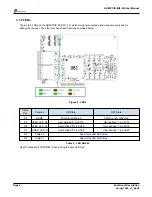
ADM-PCIE-8K5-FH User Manual
3.2 Clocking
The ADM-PCIE-8K5-FH provides reference clocks for the DDR4 SDRAM banks and the I/O interfaces available
to the user. After a clock is programmed to a certain frequency, that frequency will become the default on
power-up. Any clock out of an Si5338 Clock Synthesizer is re-configurable over I2C. This allows the user to
configure almost any arbitrary clock frequencies during application run time. Please see the Alpha Data API
functions for examples of how this is done.
Note: use "set_property BITSTREAM.CONFIG.UNUSEDPIN {Pullnone} [current_design]" to ensure the user
design does not interfere with the I2C interface to the reprogramable clock generator.
SFP0 156.25MHz Factory Default (MGTREFCLK0_127)
FireFly 156.25MHz Factory Default (MGTREFCLK0_232)
Card Edge PCIe
Ref Clock (100MHz)
25MHz
20ppm
Source
Si5338
Clock
Synth
SFP1 156.25MHz Factory Default (MGTREFCLK0_228)
NB6L11S
Fanout
Memory Interface Clock 300Mhz (IO Bank 66)
Memory Interface Clock 300Mhz (IO Bank 44)
FABRIC_CLK 200MHz (IO Bank 64)
200MHz, 30ppm
Source
EMCCLK 100MHz (IO Bank 65)
100MHz, 10ppm
Source
NB6L11S
Fanout
PCIe Ref Clock_1 (MGTREFCLK0_224)
PCIe Ref Clock_2 (MGTREFCLK1_231)
External Ref Clock
Ext Ref Clock (MGTREFCLK1_232)
Figure 7 : Clock Topology
3.2.1 PCIe Reference Clocks
The 8 MGT lanes connected to the PCIe card edge use MGT tiles 224/225 and use the system 100 MHz clock
(PCIE_REFCLK).
A second PCIe reference clock is buffered up from the edge to the FireFly module MGT tiles (231/232).
Signal
Target FPGA Input
I/O Standard
"P" pin
"N" pin
PCIE_REFCLK_1
MGTREFCLK1_231
LVDS
H10
H9
PCIE_REFCLK_2
MGTREFCLK0_224
LVDS
AT10
AT9
Table 5 : PCIe Reference Clocks
3.2.2 Fabric Clock
The design offers a fabric clock called FABRIC_CLK which is permanently fixed at 200 MHz. This clock is
intended to be used for IDELAY elements in FPGA designs. The fabric clock is connected to a Global Clock (GC)
pin.
Page 7
Functional Description
ad-ug-1342_v1_0.pdf












































